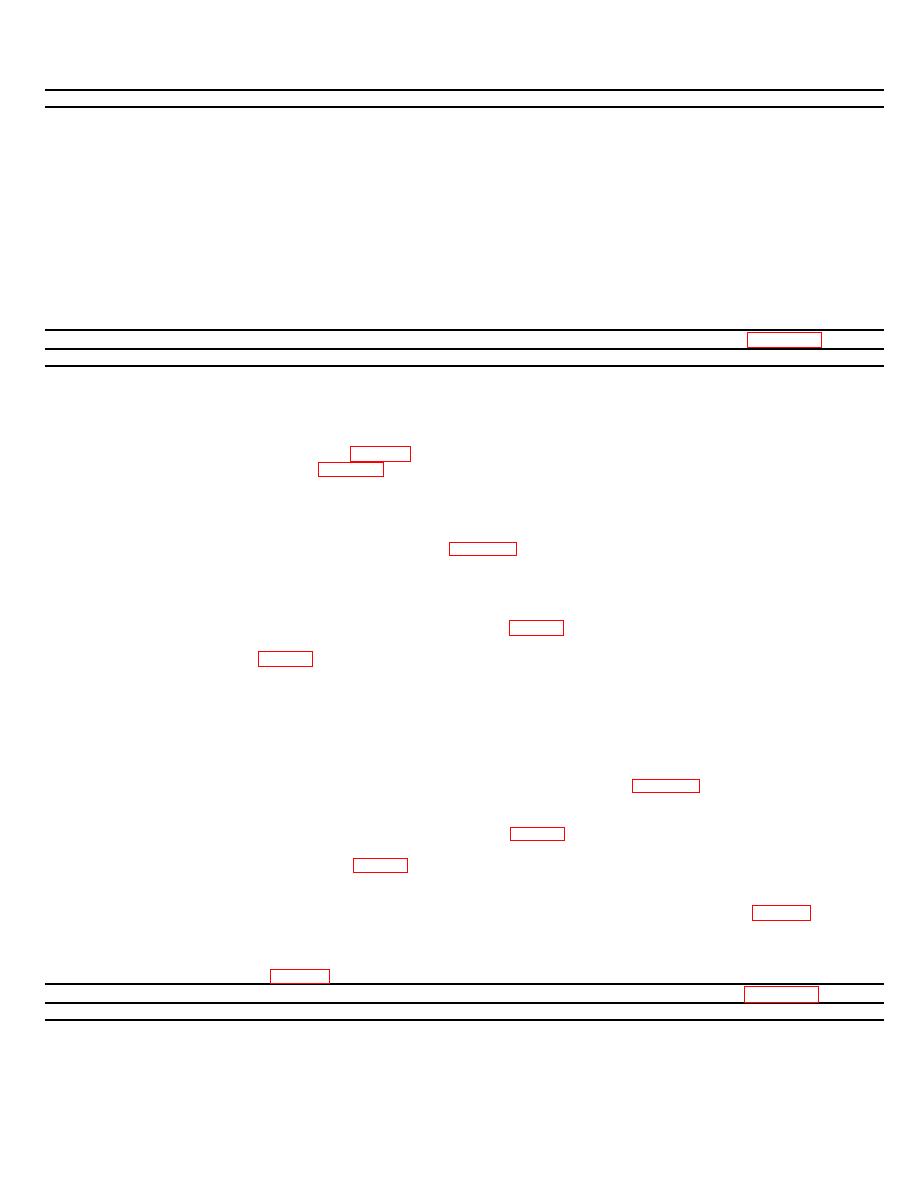 |
|||
|
|
|||
|
Page Title:
Table 7-2. Application of Materials for Blocking and Tiedown of LACV-30 Components Shown in Figure 7-1 |
|
||
| ||||||||||
|
|
 TM 55-1930-218-14
Table 7-1 Continued
Item
Description
Approximate Quantity
6- x 8-inch
51 linear ft
Plywood
3/4-inch thick
4 square ft
Styrofoam
Beadboard, 4-inch x 4- x 8-foot (may also be supplied in 4-inch x 2- x 8-foot sheets)
55 sheets
Nails
Common, steel; flathead; bright; table XI-b, Fed Spec FT-N-105B: 20d
70
30d
80
40d
480
Wire rope
6x19, IWRC; improved plow steel; preformed, regular-lay; table X, Fed Spec RR-W-410C:
268 ft
3/8 inch
Thimbles
Standard, open-type: 3/8-inch
36
Clamps
Wire rope, U-bolt clips, saddled, single-grip, steel, Crosby heavy-duty, or equal; Fed Spec
148
FF-C-450D: 3/8-inch
Turnbuckles
Eye-and-eye, galvanized, weldless, dropforged, 5/e-inch eyes, 12-inch takeup
8
Strapping
Steel, high tension; Fed Spec QQ-S-781H, type I or IV, 1 1/4- x .035-inch
1,215 ft
Seals
Steel strapping; Fed Spec QQ-S-781H, type D
410
Table 7-2. Application of Materials for Blocking and Tiedown of LACV-30 Components Shown in Figure 7-1
Item
No. Required
Application
A
Styrofoarn Beadboard, 4-inch x 4- x 8-foot sheets or 4-inch x 2- x 8-foot sheets. Distribute beneath the
sectionalized components to protect the hinge attachment points and to provide separation of the components
from the railcar deck. Position between all stacked components to protect the hinge attachment points and to
provide separation between components. Arrange so that approximately 50 to 60 percent of all bottom
surfaces rest on the styrofoam bead-board.
B
16
Chock blocks (detail 1, fig 7- 10). Locate Flat portion of the block against both sides of the components.
Space as shown in figure 7-1. Before nailing, install item C. Nail heel of block to car floor with three 40d nails,
and toenail both sides of block to car floor with two 40d nails.
C
12
Filler strips. Cut pieces of 2- x 4- x 10-inch lumber and install between the side of the power module with port
midcraft buoyancy box and the upper face of the chock blocks. The filler strip serves as a bearing plate for the
face of the chock block and prevents pressure from being placed against the flange.
D
8
Wire rope, 3/8-inch. Locate as shown in figure 7-1. Form a complete loop through the railcar stake pocket
and one eye of the turnbuckle (item G). Form a complete loop through the tiedown point of the module and
the other eye of the turnbuckle. The ends of both loops of the wire rope must overlap at least 15 inches.
E
28
Clamps, 3/8-inch. Secure the ends of the wire rope at the overlap areas with four clamps spaced 21/4 inches
apart, leaving a minimum of 6 inches from ends of rope. Place one additional clamp to secure thimble (item
F) and wire rope together at stake pocket (detail 2, fig 7-10).
F
4
Thimble, open-type, 3/8-inch. Place one at bottom of each stake pocket where wire rope passes through
(detail 2, fig 7-10). Attach thimble to wire rope with one clamp (item E).
G
4
Turnbuckles, 5/8-inch eyes. Tighten turnbuckles until wire rope loops are tensioned enough to cause a slight
depression of Styrofoam Beadboard under load. DO NOT OVERTIGHTEN. Wire-tie turnbuckles to prevent
loosening during transit.
H
16
Strapping boards, 2- x 4- x 10-inch lumber, beveled to fit top edges of modules. Position under steel straps
(item K) to protect flanges and corners of modules.
J
2
Strapping boards, 1- x 4-inch x 10-foot lumber. Position under steel straps (item K) across walkways of cabin
module.
K
10
Steel straps, 1 1/4- x .035-inch x cut-to-length. Position as shown in figure 7-1. Each strap is fabricated by
looping a length of strapping through the stake pocket on each side of the railcar, with a pad (item L) between
the strap and the railcar stake pocket. The loops are formed by attaching two seals (item M), butted together,
at least 18 inches above the railcar deck (detail 3, fig 7-10). Overlap the two lengths of strapping at the top of
the load, tighten, and join with two seals butted together. All seals at strapping joints must have two pairs of
crimps per seal (detail 4, fig 7-10).
L
20
Pad, 1 /4- x .035 x 18-inch steel strap. Position under and seal to item K at each stake pocket (detail 3, ft 7-
10).
M
80
Seals, steel strapping. Two seals required for joining strapping at each joint (detail 4, fig 7-10). One seal
required for securing each pad (item L) to strap.
Bracing. Consists of 2- x 8-inch x cut-to-length lumber. Brace as required between modules to prevent for-
N
as required
and-aft movement. Secure to car deck and to other bracing with 40d nails. Lumber for this requirement not
included in table 7-1.
Table 7-3. Application of Materials for Blocking and Tiedown of LACV-30 Components Shown in Figure 7-2
Item
No. Required
Application
A
Styrofoam beadboard, 4-inch x 4- x 8-foot sheets, or 4-inch x 2- x 8-foot sheets. Distribute beneath the
sectionalized components, except the crated propellers, to protect the hinge attachment points and to provide
separation of the components from the railcar deck. Position between all stacked components, except the
crated propellers, to protect the hinge attachment points and to provide separation between components.
Position between the ends of the port and starboard aft side decks and the railcar bulkhead. Arrange so that
approximately 50 to 60 percent of ail bottom surfaces rest on the styrofoam beadboard.
7-8
|
|
Privacy Statement - Press Release - Copyright Information. - Contact Us |